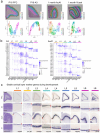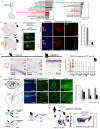This is a preprint.
Molecular architecture of primate specific neural circuit formation
- PMID: 38562839
- PMCID: PMC10984012
- DOI: 10.21203/rs.3.rs-4082064/v1
Molecular architecture of primate specific neural circuit formation
Abstract
The mammalian cortex is a highly evolved brain region, but we still lack a comprehensive understanding of the molecular mechanisms underlying primate-specific neural circuits formation. In this study, we employed spatial transcriptomics to assess gene expression dynamics in the marmoset cortex during development, focusing on key regions and time points. Spatial transcriptomics identified genes that are sexually, spatially, and temporally differentially expressed in the developing marmoset cortex. Our detailed analysis of the visual cortex unveiled dynamic changes in gene expression across layers with distinct projections and functions. Notably, we discovered numerous axon guidance molecules with spatiotemporal expression patterns unique to the developing marmoset prefrontal cortex (PFC), which control PFC neuronal circuits. Among these molecules, PRSS12 (Protease, Serine, 12 (neurotrypsin, motopsin), when ectopically expressed in the mouse prelimbic cortex, caused similar changes in connectivity as observed in the marmoset A32 area. Furthermore, PRSS12 showed similar expression patterns in both marmoset and human PFC during development, suggesting parallels between marmoset and human brain development. The differential expression of axon guidance molecules in the developing PFC, varying by region, likely contributes to the formation of unique circuits observed in primates.
Conflict of interest statement
Declaration of interests The authors declare no competing financial interests.
Figures





Similar articles
-
Local and long-distance organization of prefrontal cortex circuits in the marmoset brain.Neuron. 2023 Jul 19;111(14):2258-2273.e10. doi: 10.1016/j.neuron.2023.04.028. Epub 2023 May 16. Neuron. 2023. PMID: 37196659 Free PMC article.
-
Developmental expression profiles of axon guidance signaling and the immune system in the marmoset cortex: potential molecular mechanisms of pruning of dendritic spines during primate synapse formation in late infancy and prepuberty (I).Biochem Biophys Res Commun. 2014 Feb 14;444(3):302-6. doi: 10.1016/j.bbrc.2014.01.024. Epub 2014 Jan 30. Biochem Biophys Res Commun. 2014. PMID: 24485715
-
Spatial transcriptomics reveals the distinct organization of mouse prefrontal cortex and neuronal subtypes regulating chronic pain.Nat Neurosci. 2023 Nov;26(11):1880-1893. doi: 10.1038/s41593-023-01455-9. Epub 2023 Oct 16. Nat Neurosci. 2023. PMID: 37845544 Free PMC article.
-
Recent advances in understanding neuronal diversity and neural circuit complexity across different brain regions using single-cell sequencing.Front Neural Circuits. 2023 Mar 30;17:1007755. doi: 10.3389/fncir.2023.1007755. eCollection 2023. Front Neural Circuits. 2023. PMID: 37063385 Free PMC article. Review.
-
Application of viral vectors to the study of neural connectivities and neural circuits in the marmoset brain.Dev Neurobiol. 2017 Mar;77(3):354-372. doi: 10.1002/dneu.22459. Epub 2016 Oct 26. Dev Neurobiol. 2017. PMID: 27706918 Free PMC article. Review.
References
-
- Fuster J. M. The prefrontal cortex. Fifth edition. edn, (Elsevier/AP, Academic Press is an imprint of Elsevier, 2015).
Publication types
Grants and funding
LinkOut - more resources
Full Text Sources
Miscellaneous

